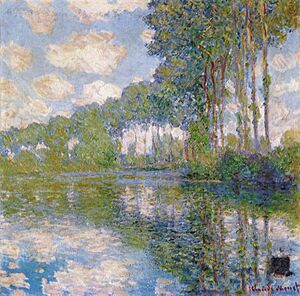Epte facts for kids
The Epte is a beautiful river in France. It flows through the Normandy region. You can find it in the areas of Seine-Maritime and Eure. The Epte is a tributary of the famous Seine river. This means it's a smaller river that flows into a larger one.
The river starts in the Pays de Bray area. This is in the Seine-Maritime department. It begins near a town called Forges-les-Eaux. The Epte then flows until it joins the Seine river. This meeting point is close to the village of Giverny.
Contents
A River with a Rich History
The Treaty of Saint-Clair-sur-Epte
The Epte River has been important for a very long time. In the year 911, a very important agreement was made. It was called the Treaty of Saint-Clair-sur-Epte. This treaty made the Epte River a historical border. It became the dividing line between two regions: Normandy and Île-de-France.
Dividing the Vexin Region
This treaty also split a region called the Vexin into two parts. One part was called the Norman Vexin. It became part of Normandy. The other part was the French Vexin. This part stayed with the Île-de-France region. Because the river was a border, many castles were built. These castles stood on both sides of the Epte. They were there to protect the frontier.
Claude Monet's Inspiration
Giverny and the Water Garden
The famous artist Claude Monet lived near the Epte River. He lived in the village of Giverny for over forty years. Monet loved nature and his garden. He even changed a small part of the Epte. He used its water to create a special water garden. This garden had his famous water-lily pond. It also had a beautiful Japanese-style bridge.
The Epte in Art
The Epte River appeared in many of Monet's paintings. One famous painting is called Peupliers au bord de l'Epte. This means "Poplars on the Banks of the Epte." It shows the tall trees along the river. The river's beauty inspired many of his masterpieces.
See also
 In Spanish: Río Epte para niños
In Spanish: Río Epte para niños


